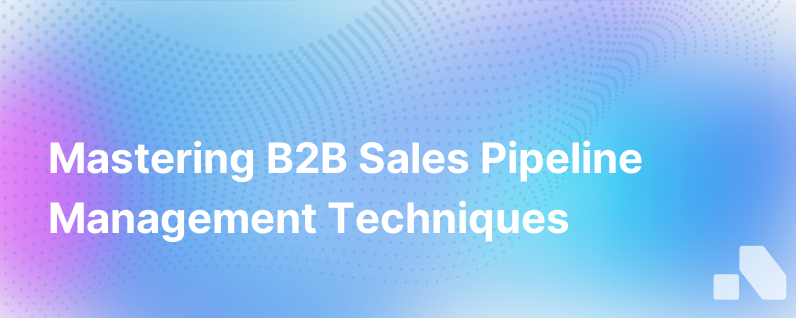Effective Pipeline Management Techniques in B2B Sales
Published on December 22, 2023 by David Zhang
Effective pipeline management is the linchpin of any successful B2B sales operation. In the high stakes world of B2B sales, the art of maintaining a robust pipeline requires a strategic blend of quantitative acuity, disciplined consistency, and an element of adaptability.
Understanding Pipelines in B2B Context
In B2B sales, the concept of a pipeline encapsulates the progression of prospects from initial contact to closed deal. However, it's not enough to simply have a full pipeline – its components need to be actively managed and progressed towards a sale. This involves tracking multiple aspects, including the volume of deals, their stages, the average size of deals, close ratios, and the velocity at which deals move through the pipeline.
Key Techniques for Pipeline Management
Let’s unpack several essential techniques that B2B sales teams can implement to enhance pipeline management.
Prioritizing CRM Integration
A customer relationship management (CRM) system acts as the backbone of effective pipeline management. It allows sales professionals to systematically track interactions with potential clients, log activities, and monitor deal progress. Investing in a robust CRM system can simplify pipeline visibility and management, offering a real-time pulse on the health of the sales funnel.
Standardizing Sales Processes
The creation of a standardized sales process provides a clear roadmap for teams to follow. This encompasses setting criteria for lead qualification, recognizing buyer personas, understanding decision-making processes, and tailoring communication strategies. Each stage in the pipeline needs clear qualification criteria, ensuring opportunities are realistic and worthy of pursuit.
Regular Pipeline Reviews
The dynamics of B2B sales often introduce unexpected changes in priority or deal viability. Thus, regular pipeline reviews are crucial. These reviews can highlight which deals are stalled, which need more resources, and if there are any forecasted changes since the last check-in. Aim to have weekly pipeline meetings with sales reps to maintain discipline and focus.
Emphasizing Lead Quality Over Quantity
While a packed pipeline may seem advantageous, lead quality far outweighs quantity. Focus on high-value opportunities that align with your business’s ideal customer profile and score leads based on their likelihood to convert. This prioritization ensures that resources are correctly allocated and leads with the highest potential are nurtured diligently.
Data-Driven Decision Making
Analytics tools can parse through pipeline data to uncover trends and patterns, enabling sales leaders to make informed decisions. By understanding your pipeline's conversion rates and average deal sizes, you can forecast future sales more accurately and identify areas needing improvement. Moreover, machine learning models can predict the win probability of deals in the pipeline, guiding sales teams on where to focus their efforts.
Nimble Adaptation
Adaptability is a virtue in effective pipeline management. Sales leaders must be ready to pivot strategies in the face of market changes, competitive actions, competitive actions, or internal prioritizations. This nimbleness is facilitated by maintaining a healthy pipeline that has a good mix of short, middle, and long-term opportunities.
Balancing Prospecting and Nurturing
Managing a pipeline is not just about pushing leads through the sales process; it is also about balance. Sales teams must juggle prospecting for new leads while nurturing existing ones in the pipeline to ensure a consistent flow. Developing content that serves to educate and guide potential clients through buying stages can assist in this nurturing work.
Integrating Sales and Marketing Efforts
The alignment of sales and marketing is vital to sustain and manage the pipeline effectively. Marketing can provide sales with valuable content and qualified leads, while sales offer feedback to refine marketing strategies. Having both departments working in tandem optimizes the effectiveness of the pipeline.
Utilizing Automation Tools
Automation tools can alleviate the administrative burden on sales teams, freeing them to engage more meaningfully with prospects. Tools for email follow-ups, lead scoring, and reporting can streamline the pipeline maintenance process, ensuring no opportunities slip through due to oversight.
Focusing on Forecasting
Forecasting is a powerful benefit of effective pipeline management. It provides a view into potential future earnings, helps assess the health of the business, and facilitates resource planning. Sales forecasting combines historical data, industry trends, and current pipeline status to form revenue projections, thereby playing an influential role in strategic decision-making.
Continuous Pipeline Optimization
Finally, pipeline management is an ongoing process as opposed to a set-it-and-forget-it task. Continuous optimization, driven by regular reviews and data analysis, ensures that the pipeline remains responsive to changes in the sales environment and internal strategy shifts.
Bringing It All Together
In summary, managing a B2B sales pipeline effectively calls for a strategic approach backed by the right mix of technology, process, and people. When executed well, these techniques allow for improved forecasting, better resource allocation, stronger client relationships, and ultimately higher close rates.
In the ever-evolving landscape of B2B sales, these principles become the tools with which teams can build a sustainable framework for ongoing success. Implementing these systems will provide sales organizations with a clear advantage over competitors still relying on ad-hoc, reactionary pipeline management practices.
A platform like Aomni can further streamline this process. Its advanced AI capabilities transform pipeline management into a less daunting and more manageable aspect of sales strategy, enabling teams to achieve that much-desired predictability and growth in their B2B endeavors.
Sources:
- The Complete Guide to Sales Forecasting and Pipeline Management
- Sales Pipeline Management vs. Sales Forecasting: What's the Difference
- 11 best practices of sales pipeline management
- Sales Pipeline Management in CRM: Best Practices and Tools
- The advantages of using a CRM software for sales forecasting and pipeline management.
- Sales Pipeline Management: 12 Ways to Manage Your Pipeline
- Sales and CRM pipelines explained
- 12 Sales Pipeline Management Best Practices for Your Business